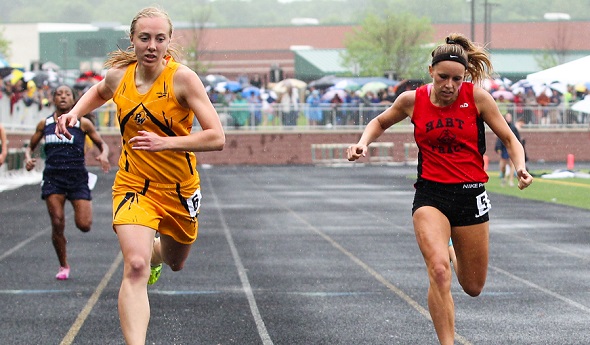
Wirth Shows Worth Again for D3 Power
June 2, 2016
By Dean Holzwarth
Special for Second Half
WESTPHALIA – This past March, fewer than 2 minutes remained in Pewamo-Westphalia's Class C Regional Semifinal basketball loss to Ypsilanti Arbor Prep when junior Brenna Wirth heard a pop in her right ankle.
 She fell to the floor in pain, unaware if her upcoming track and field season would be in jeopardy.
She fell to the floor in pain, unaware if her upcoming track and field season would be in jeopardy.
“That was one of my main concerns when it happened because I didn’t know how bad it was at first,” Wirth said. “It hurt a lot, and I heard a pop when it happened. I think I came down on a girl’s ankle and I was pretty worried.”
Wirth’s anxiety was eased by the good news that awaited her after the game. It turned out to be only a badly sprained ankle. Nothing worse.
“I got lucky I guess,” Wirth said. “But it has motivated me to push myself a little harder to get back to where I want to be.”
Wirth, one of the elite sprinters in Lower Peninsula Division 3, has fully recovered from the injury and is expected to compete in Saturday’s MHSAA Track & Field Finals at Comstock Park High School.
The Pirates have won two MHSAA girls track and field championships over the past three years and will look to go back-to-back Saturday.
Wirth will be an important component in their quest.
“We have a lot of depth, and she is part of that,” P-W track and field coach Scott Werner said. “One of the first pieces we look at is where we can utilize Brenna, and then we build around her to maximize our team points.”
She is thankful the ankle injury didn’t set her back longer than a few weeks.
“It healed a lot faster than I thought it would,” Wirth said. “I slowly began walking on it again, and I went from there. I’m excited for this weekend, and I think our team has a good shot this year again.”
Werner said Wirth has made the necessary strides to make a speedy comeback.
“I consider her healthy now,” he said. “She has been building up and feeling as good as she has the whole year. Things are starting to come together, and we hope we can peak this Saturday and finish things off right.”
Wirth will take part in the 200 and 400, as well as join her teammates as a member of the top-ranked 400 and 800 relay teams.
She won both individual events at last week’s Regional and is considered among the favorites to take home an individual title Saturday.
Wirth has plenty of motivation, especially in the 400, which is her signature event. She placed runner-up at the Finals as a freshman and sophomore.
“I’ve gotten so close in the 400 these past few years, so I’m hoping this is the year,” Wirth said. “I just want to give it my best effort. I’ve worked hard all season to get to this point, so I’m just hoping to run fast for the team. My team is the end goal, everything for them.”
Wirth’s work ethic separates her from other athletes, and it has helped propel her to success on the track and in other sports.
She also competes on the cross country team and delivered a new personal record at the Finals last fall.
“She is just a real athletic kid, and every sport that she is part of she is very good at,” Werner said. “She is such a hard worker, and where she excels at the most the past few years is the 400. That’s a type of race that you have to grind through, and she’s really strong mentally. She can go in and fight through and do her thing.”
Wirth will run Saturday without her older sister, Marissa, by her side. The two shared the track and past two seasons before Marissa graduated.
They drove each other to compete at the highest level.
“We ran on the same relays, and at times I had to run against her,” Wirth said. “It’s a lot different this year, and I really do miss her. She really pushed me, and I think I helped push her a lot. We kept each other going.”
Wirth made her presence known early on in her high school career, emerging as one of the top sprinters on a team chock-full of talented runners.
“She immediately came in and was among our best sprinters of what I would consider a pretty strong sprint program the past few years,” Werner said. “She was an instant-impact-type kid. She has a real positive attitude and sets a really great tone. She’s a good leader, and she’s a part of the strong culture that we have here.”
PHOTO: Pewamo-Westphalia's Brenna Wirth (left) crosses just before Hart's Jennie Gottardo to finish second in the 400 at last season's Lower Peninsula Division 3 Final. (Photo by Jamie Geysbeek/RunMichigan.com.)

Track Gaining Speed Toward Future with Electronic Starting Devices
By
Steve Vedder
Special for MHSAA.com
May 23, 2023
Aubrey Greenfield thinks it might be the perfect time to reevaluate 130 years of tradition.
For a number of reasons, from technical to personal, the Oxford senior sprinter believes it makes sense for the crack of a starting pistol to be eliminated from high school track meets.
Because track meets would benefit in various ways from lowering costs to easier setup at meets to the human factor of competitors not having to flinch at the crack of a pistol shot, Greenfield believes the sport has a chance to embrace new technology – electronic starting devices (ESD).
In essence, an ESD replaces the starting pistol with a light flash, tone sound or both to begin a race.
"High school sports should put the athlete first," Greenfield said. "We should promote sports, and eliminating starting pistols promotes health in terms of PTSD or trauma for athletes and spectators and that would be good. I would like to think people would say that's a good idea."
In fact, Greenfield would go as far as to say if there was not an implementation of electronic starting devices, many of her teammates would have considered giving up the sport.
"If it's something that helps us compete safely, we're all for it," she said.
Greenfield's opinion apparently is spreading. Michigan High School Athletic Association senior assistant director Cody Inglis said the use of ESD makes it both affordable for meet starters and sensible for athletes and fans to rethink the use of starting pistols. While the MHSAA is not mandating electronic starting devices, it does promote the use of what Inglis calls "emerging technology." He notes that ESD are becoming the norm for organizations such as USA Track & Field, the NCAA and an increasing number of high schools.
 "I think we have to embrace new technology, and we think this will be something that takes hold," Inglis said.
"I think we have to embrace new technology, and we think this will be something that takes hold," Inglis said.
A key part of embracing ESD is the human element. The tragic Oxford High School shooting Nov. 30, 2021, that took the lives of four students while injuring seven others should not be relived even for a fleeting instance at a high school sporting event. Oxford athletic director Tony DeMare said the school began using ESD at every meet, including the MHSAA Lower Peninsula Division 1 Finals last June. He said that decision was embraced by virtually all schools Oxford encountered.
"We were very convinced that the alternative (of ESD) would promote a healthy attitude," DeMare said. "We were overwhelmed with the positive response. If a school was on the fence about it or might not be for it, I think we've started to see the tide turn in favor of people willing to listen and learn about electronic starting devices."
Inglis said the MHSAA is acutely aware of what the crack of a starting pistol can mean to athletes and fans.
"It's unimaginable what Oxford went through, and this is a small way we can help," he said. "We look at a (starting pistol) and think, ‘Could we do something else?’ It's a way of helping to solve a problem."
Over the last several years, the MHSAA has embraced finding an alternative to starting pistols. Inglis noted the discussion started with the cost and diminishing availability of 32-caliber ammunition that meet starters use. A box of ammunition, if it can be found, is around $75 a box.
In addition to cost, there is potential damage from excessive exposure to 150-plus decibels of sound generated by the traditional 32-caliber blanks. Medical studies show damage to ears caused by decibel levels above 120 dB.
The tragedy at Oxford accelerated the conversation.
Inglis said the cost of ESD can be likened to a school sinking money into artificial surfaces at football fields. Yes, there is a great cost at first, but over time money is ultimately saved. An ESD system itself ranges between $200 and $500. Speakers also may need to be purchased, but with ESD starting events like the 800 and 1,600-meter relays positioned near the outside lanes 8, 7, 6 and 5 would result in improved hearing by athletes at the start of a race.
There is one challenge with ESD that track administrators are working to overcome – lighting conditions that lessen the ability to see the ESD’s LED light or strobe when the button is pressed by a starter to begin a race. But that vision difficulty resulting from clear blue skies and backgrounds of setting suns can be substantially improved by incorporating a black background with an ESD – something as simple as a starter holding up black cardboard behind the lighting mechanism at the start of an event.
Inglis said when all factors are considered, the use of ESD makes sense.
 "With the climate we live in nowadays, no lookalike guns is good," he said. "We're not mandating this. But people are saying this is affordable."
"With the climate we live in nowadays, no lookalike guns is good," he said. "We're not mandating this. But people are saying this is affordable."
While switching to ESD would break 130 years of tradition, the timing could be a step forward, said Jeff Hollobaugh, co-author of the book "The Fleet Feet of Spring: Michigan's High School State Championships in Track & Field." He said while no definitive answer is possible, it's likely starting pistols were used at the inaugural state meet at the Jackson Fairgounds in 1895. The meet, which included events like tossing a 16-pound shot put, bike races and a 100-meter sprint, was sponsored by the Michigan Interscholastic Athletic Association (a predecessor to the MHSAA) and comprised mostly of the state's larger schools.
Hollobaugh's sentiments echo what many involved in today's high school track & field believe in terms of making a transition from starting pistols to electronic starting devices.
"It's a change, not necessarily good or bad, just different," he said. "It's not a drastic change, but it will take some getting used to. But it is the future. In the end, we'll all be fine."
DeMare believes the future of high school track will definitely include ESD.
"Our desire is that the practicality and sensibility of this will overcome the alternative," he said. "I think we'll see the automation and electronics taking hold of certain elements in track, and people will embrace it."
PHOTOS (Top) Runners watch official Bertha Smiley as they prepare to begin a race during last season's Lower Peninsula Division 1 Finals at Rockford. (Middle) An electronic starting device provided by VS Athletics was used to start those races. (Below) Smiley sets to begin an event. (Photos provided by David Kuderka/VS Athletics.)

